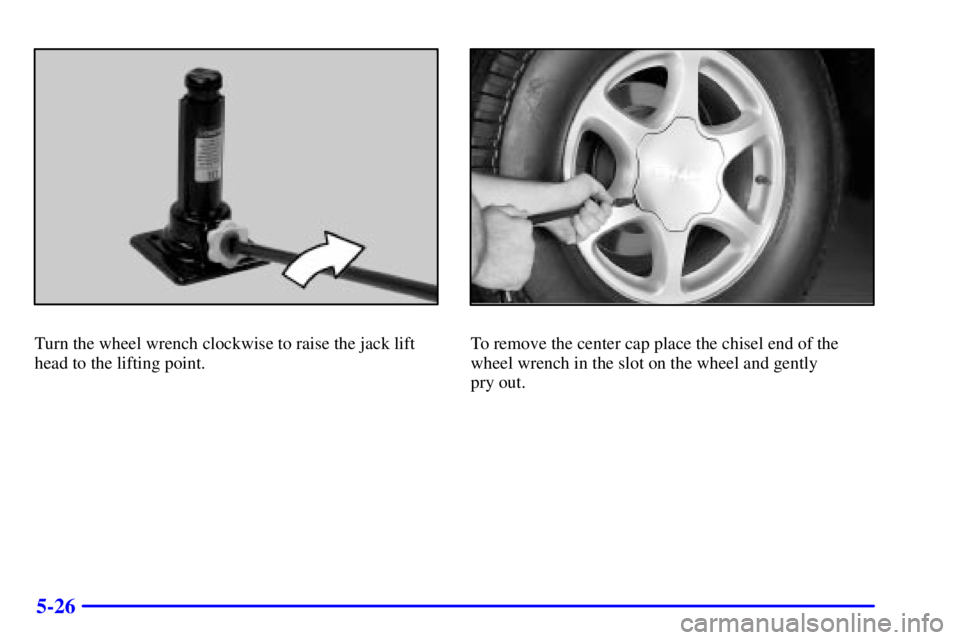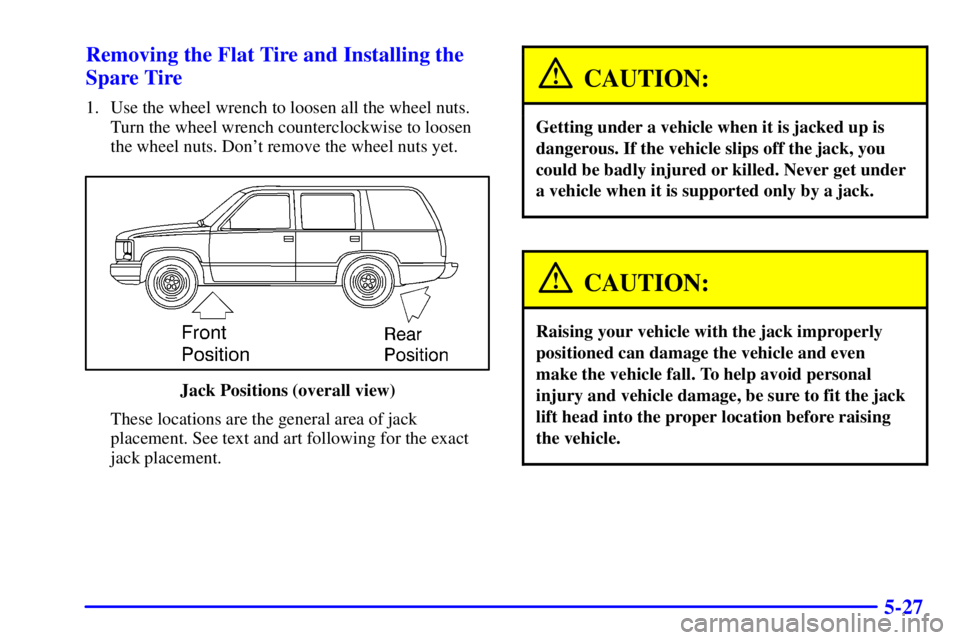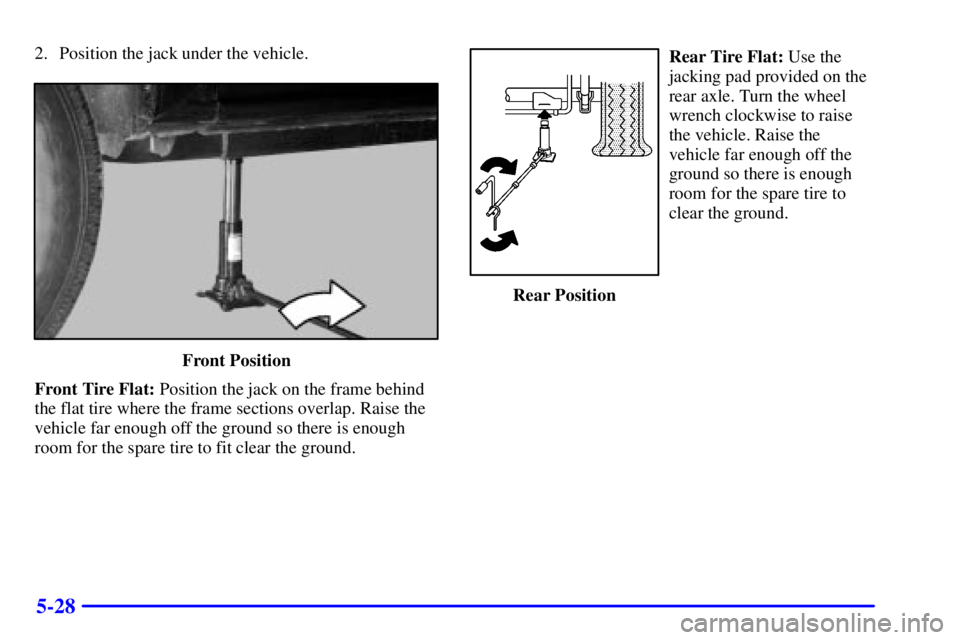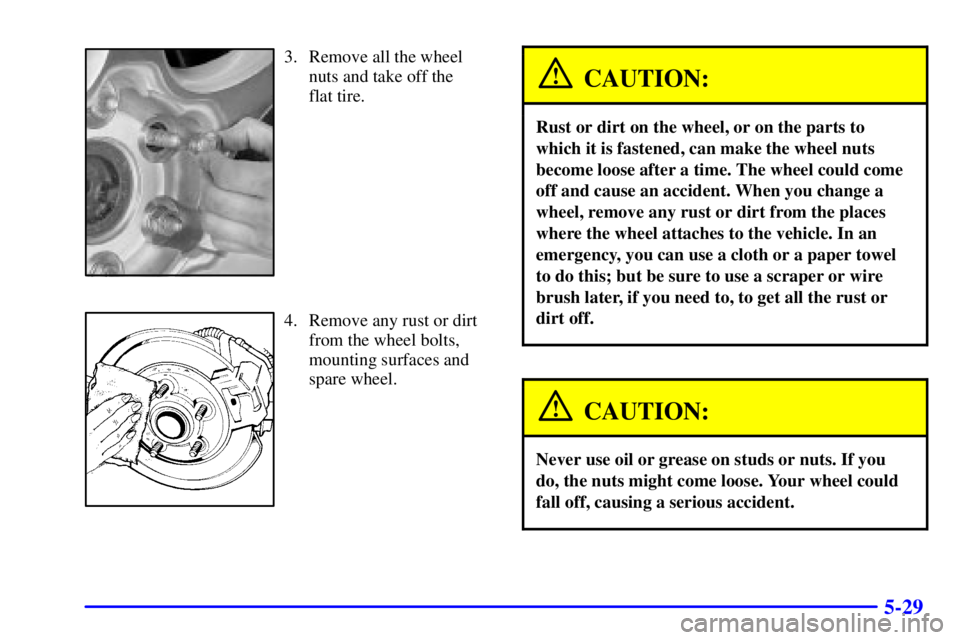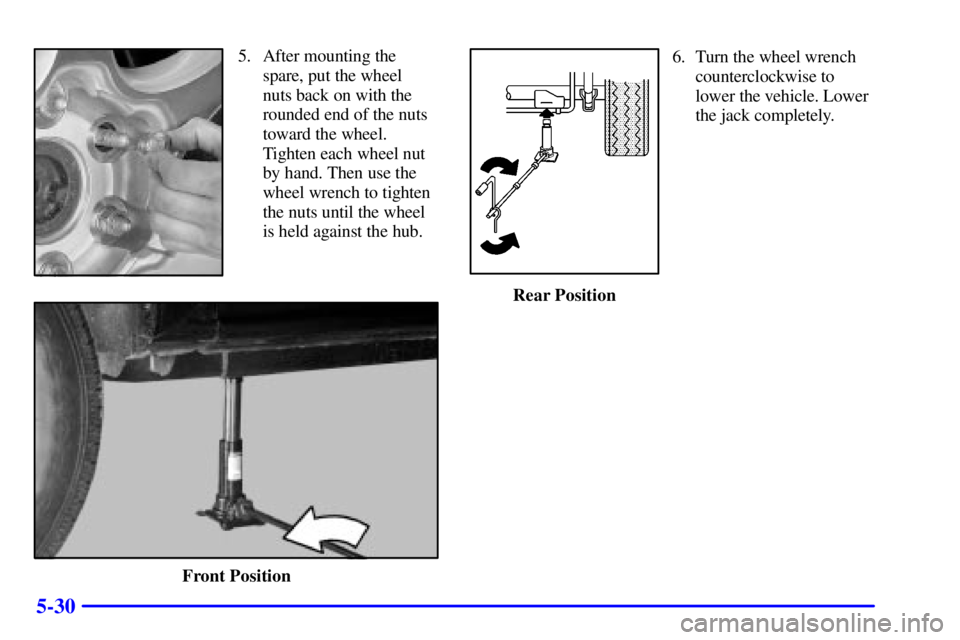GMC YUKON DENALI 2002 Owners Manual
YUKON DENALI 2002
GMC
GMC
https://www.carmanualsonline.info/img/44/57885/w960_57885-0.png
GMC YUKON DENALI 2002 Owners Manual
Trending: night vision, oil viscosity, oil pressure, lane assist, odometer, oil capacities, suspension
Page 281 of 407

5-22
Yukon XL Denali Models
A. Bottle Jack
B. Wheel Blocks
C. Wing Nut
D. Mounting Bracket
E. Removable TrayF. Retaining Hook
G. Retaining Bracket
and Wing Nut
H. Tool Kit with Jack
Tools and GlovesYukon Denali: The equipment you'll need is located
under the second row passenger's seat on the driver's
side of the vehicle, and behind the left trim panel on the
driver's side of the vehicle. Skip the first step and follow
the last three.
Yukon XL Denali: The equipment you'll need is
located under the storage tray in the rear trim panel on
the driver's side of the vehicle.
1. Remove the tray to access the tools.
2. There is a wing nut used to retain the tool kit.
To remove it, turn the wing nut counterclockwise.
3. To release the bottle jack from its holder, turn the
knob on the bottle jack counterclockwise to lower
the jack head.
4. The wheel blocks and the wheel block retainer can be
removed by turning the wing nut counterclockwise.
You'll use the jack handle extensions and the wheel
wrench to remove the underbody
-mounted spare tire.
Page 282 of 407
5-23
A. Spare Tire (Valve
Stem Pointed Up)
B. Hoist Assembly
C. Hoist Cable
D. Tire Retainer
E. Hoist Shaft
F. Hoist End of
Extension ToolG. Hoist Shaft
Access Hole
H. Wheel Wrench
I. Jack Handle
Extensions
J. Hoist Lock1. Your vehicle is equipped with a hoist lock (J).
To unlock it, open the spare tire lock cover on the
bumper and use the ignition key to remove the lock.
2. Assemble the wheel wrench (H) and the two jack
handle extensions (I) as shown.
Page 283 of 407
5-24
3. Insert the hoist end
(open end) (F) of the
extension through
the hole (G) in the
rear bumper.
Be sure the hoist end of the extension connects into
the hoist shaft (E). The ribbed square end of the
extension is used to lower the spare tire.
4. Turn the wheel wrench (H) counterclockwise to
lower the spare tire to the ground. Continue to turn
the wheel wrench until the spare tire can be pulled
out from under the vehicle.5. The wheel wrench has a
hook that allows you to
pull the hoist cable
towards you to assist in
reaching the spare tire.
6. When the tire has
been lowered, tilt the
retainer (D) at the end of
the cable so it can be
pulled up through the
wheel opening.
7. Put the spare tire near the flat tire.
Use the following pictures and instructions to remove
the flat tire and raise the vehicle.
Page 284 of 407
5-25
The tools you'll be using include the bottle jack (A), the
wheel blocks (B), the jack handle (C), the jack handle
extensions (D), and the wheel wrench (E).
If the flat tire is on a rear tire of the vehicle, you'll need
to use both jack handle extensions.Attach the wheel wrench to the jack handle extensions
(as needed). Attach the jack handle to the jack.
Page 285 of 407
5-26
Turn the wheel wrench clockwise to raise the jack lift
head to the lifting point.To remove the center cap place the chisel end of the
wheel wrench in the slot on the wheel and gently
pry out.
Page 286 of 407
5-27 Removing the Flat Tire and Installing the
Spare Tire
1. Use the wheel wrench to loosen all the wheel nuts.
Turn the wheel wrench counterclockwise to loosen
the wheel nuts. Don't remove the wheel nuts yet.
Jack Positions (overall view)
These locations are the general area of jack
placement. See text and art following for the exact
jack placement.
CAUTION:
Getting under a vehicle when it is jacked up is
dangerous. If the vehicle slips off the jack, you
could be badly injured or killed. Never get under
a vehicle when it is supported only by a jack.
CAUTION:
Raising your vehicle with the jack improperly
positioned can damage the vehicle and even
make the vehicle fall. To help avoid personal
injury and vehicle damage, be sure to fit the jack
lift head into the proper location before raising
the vehicle.
Page 287 of 407
5-28
2. Position the jack under the vehicle.
Front Position
Front Tire Flat: Position the jack on the frame behind
the flat tire where the frame sections overlap. Raise the
vehicle far enough off the ground so there is enough
room for the spare tire to fit clear the ground.
Rear Tire Flat: Use the
jacking pad provided on the
rear axle. Turn the wheel
wrench clockwise to raise
the vehicle. Raise the
vehicle far enough off the
ground so there is enough
room for the spare tire to
clear the ground.
Rear Position
Page 288 of 407
5-29
3. Remove all the wheel
nuts and take off the
flat tire.
4. Remove any rust or dirt
from the wheel bolts,
mounting surfaces and
spare wheel.
CAUTION:
Rust or dirt on the wheel, or on the parts to
which it is fastened, can make the wheel nuts
become loose after a time. The wheel could come
off and cause an accident. When you change a
wheel, remove any rust or dirt from the places
where the wheel attaches to the vehicle. In an
emergency, you can use a cloth or a paper towel
to do this; but be sure to use a scraper or wire
brush later, if you need to, to get all the rust or
dirt off.
CAUTION:
Never use oil or grease on studs or nuts. If you
do, the nuts might come loose. Your wheel could
fall off, causing a serious accident.
Page 289 of 407
5-30
5. After mounting the
spare, put the wheel
nuts back on with the
rounded end of the nuts
toward the wheel.
Tighten each wheel nut
by hand. Then use the
wheel wrench to tighten
the nuts until the wheel
is held against the hub.
Front Position
6. Turn the wheel wrench
counterclockwise to
lower the vehicle. Lower
the jack completely.
Rear Position
Page 290 of 407
5-31
7. Tighten the nuts
firmly in a crisscross
sequence as shown
by turning the wheel
wrench clockwise.
CAUTION:
Incorrect wheel nuts or improperly tightened
wheel nuts can cause the wheel to become loose
and even come off. This could lead to an accident.
Be sure to use the correct wheel nuts. If you have
to replace them, be sure to get new GM original
equipment wheel nuts.
Stop somewhere as soon as you can and have the
nuts tightened with a torque wrench to the
proper torque. See ªCapacities and
Specificationsº in the Index.
NOTICE:
Improperly tightened wheel nuts can lead to
brake pulsation and rotor damage. To avoid
expensive brake repairs, evenly tighten the wheel
nuts in the proper sequence and to the proper
torque specification.
When you reinstall the regular wheel and tire, you must
also reinstall the center cap. Place the cap on the wheel
and tap it into place until it seats flush with the wheel.
Trending: air condition, lug pattern, wiper blades, overheating, manual transmission, ESP inoperative, emergency towing




